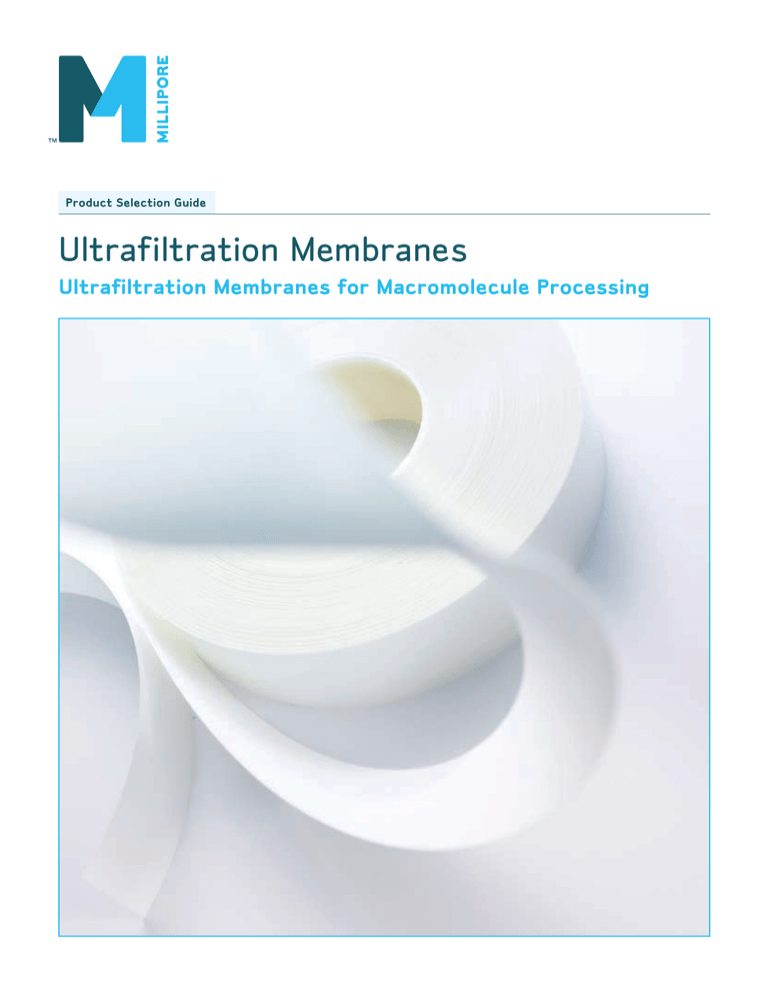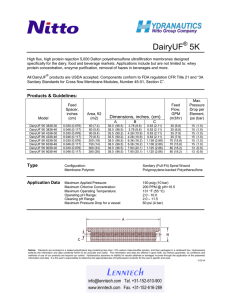
Data Sheet
Product
Selection Guide
Ultrafiltration Membranes
Ultrafiltration Membranes for Macromolecule Processing
Ultrafiltration Membranes for
Macromolecule Processing
Ultrafiltration (UF) is the process of separating
extremely small particles and dissolved molecules from
fluids. The primary basis for separation is molecular size
– particles ranging from 1,000 to 1,000,000 molecular
weight are retained by ultrafiltration membranes.
Biomax PB Membranes
ultracel PL Membranes
Biomax PB membranes are well suited for applications
requiring high flux, low to moderate protein binding,
and harsh chemical cleaning and/ or sanitization. Made
of polyethersulfone (PES), these void-free membranes
are caustic and chlorine resistant, and are modified to
reduce non-specific protein binding and fouling. The high
flux and high retention of Biomax membranes result in
faster processing speeds with higher yields. This allows
shorter processing time and more compact processing
systems.
Ultracel PL membranes are ideal for the concentration
and desalination of solutes especially when only small
volumes or low concentrations are available. The
membrane’s permeability is optimized for improved
performance with high solute retention and higher
flux levels. In addition, the regular non-voided support
layer is also more resistant to damage due to handling,
manufacture or process condition variations.
Product Features
• Available in a broad range of molecular weight cut-
Product Features
•Composite PES membrane provides a stable hydraulic
environment for excellent mechanical strength and
integrity.
•Void-free structure results in higher flux, excellent
offs.
• Polypropylene backing material provides support
without impeding flow.
• Low to moderate protein binding.
retention, and higher yields.
Millipore’s UF membranes are manufactured in our world
class facility in Jaffrey, New Hampshire. This state-ofthe-art facility is dedicated to the reliable production of
our high quality UF membranes, deploying gMP practices
and ISO compliant measures. The 44,000 sq ft facility
is a Commissioned Class 100K controlled environment;
containing the most innovative manufacturing
equipment and processes in the industry.
This guide provides an introduction to Millipore’s
family of Ultrafiltration Membranes and an overview of
the key criteria and product characteristics to consider
when selecting an UF membrane for your application
or medical device. Using this guide will help ensure
high levels of retention; however optimization through
experimentation should always be conducted to find a
suitable balance between retention and flow rate levels.
•Low to moderate protein binding – for use with
Biomax
PB Membranes
®
protein solutions containing more than 0.1 mg/mL of
protein.
•Available in a broad range of molecular weight cut-offs
to suit a variety of applications.
Ultracel®
PLC Membranes
Ultracel®
PL Membranes
Ultracel PLC Membranes
Product Features
Product Features
For a complete listing of our membrane products, please
visit www.millipore.com/oemproducts.
improved integrity.
• Ultra-low protein binding – for use with protein
solutions (less than 0.1 mg/mL).
Viresolve
Membranes
Virus contamination poses a threat to the safety
of clinical compounds derived from recombinant or
human plasma sources. Patented, composite Viresolve
membranes provide reliable and consistent viral
clearance. Viresolve membranes are available in varieties
suitable for normal-flow and tangential-flow filtration.
Ultracel PLC membranes are the membranes of
choice for high-recovery purification. These void-free
membranes combine ultra-low protein binding and low
fouling with solvent resistance and superb mechanical
strength. Casting the regenerated cellulose membrane
onto a microporous polyethylene substrate creates
a uniform, robust structure, with high integrity and
greater resistance to back pressure.
• Void-free structure results in excellent retention and
®
Viresolve Membranes
• Composite structure gives the membrane improved
back pressure resistance.
• Available in a broad range of molecular weight cut-offs
to suit a variety of applications.
• Low-binding polyvinylidene fluoride structure yields
high protein recovery (greater than 90%).
• Greater than 3 log removal of viruses for quantifiable
virus load reduction.
• Suitable for normal-flow and tangential-flow filtration
applications.
Biomax PB Membranes
Membrane Name
NMWL Cuttoff
Membrane Material
Biomax 8
Biomax 10
Biomax 30
Biomax 50
Biomax 100
Biomax 300
Biomax 500
Biomax 1000
PBSEQ
5 kiloDalton
8 kiloDalton
10 kiloDalton
30 kiloDalton
50 kiloDalton
100 kiloDalton
300 kiloDalton
500 kiloDalton
1000 kiloDalton
8 kiloDalton
Polyethersulfone
Polyethersulfone
Polyethersulfone
Polyethersulfone
Polyethersulfone
Polyethersulfone
Polyethersulfone
Polyethersulfone
Polyethersulfone
Polyethersulfone
Polyolefin Nonwoven
Polyolefin Nonwoven
Polyolefin Nonwoven
Polyolefin Nonwoven
Polyolefin Nonwoven
Polyolefin Nonwoven
Polyolefin Nonwoven
Polyolefin Nonwoven
Polyolefin Nonwoven
Polyolefin Nonwoven
Dextran Retention
90% at 10 kD
90% at 18 kD
90% at 15 kD
90% at 70 kD
90% at 95 kD
90% at 160 kD
BP ≥ 80 psi
BP ≥ 45 psi to ≤ 90 psi
BP ≥ 30 psi to ≤ 55 psi
90% at 18 kD
Thickness
280 microns
280 microns
280 microns
280 microns
280 microns
280 microns
280 microns
280 microns
280 microns
280 microns
Air Permeability
0 at 30 psi
0 at 30 psi
0 at 30 psi
0 at 30 psi
0 at 30 psi
0 at 30 psi
0 at 30 psi
0 at 30 psi
1 ml/min at 10 psi
0 at 30 psi
Water Flux
3.5 lmh/psi
10 lmh/psi
27 lmh/psi
37.5 lmh/psi
47.5 lmh/psi
95 lmp/psi
230 lmh/psi
390 lmh/psi
750 lmh/psi
15 lmh/psi
Membrane Code
PBCC
PBFC
PBGC
PBTK
PBQK
PBHK
PBMK
PBVK
PBXK
PBSEQ
pH range
1–14
1–14
1–14
1–14
1–14
1–14
1–14
1–14
1–14
1–14
Max Operating Temp
80 °C
80 °C
80 °C
80 °C
80 °C
80 °C
80 °C
80 °C
80 °C
80 °C
30 inches*
15 inches**
30 inches*
30 inches*
30 inches*
30 inches*
15 inches**
15 inches**
30 inches*
15 inches**
400 feet
400 feet
400 feet
400 feet
400 feet
400 feet
400 feet
400 feet
400 feet
400 feet
Support Material
High Flux
Biomax 5
Max Support Width
Standard Length
Maximum Retention/Lowest Binding
Ultracel PLC Membranes
Membrane Name
Ultracel 5 kD
Ultracel 8 kD
Ultracel 10 kD
Ultracel 20 kD
Ultracel 30 kD
Ultracel 100 kD
Ultracel 300 kD
Ultracel 1000 kD
5 kiloDalton
8 kiloDalton
10 kiloDalton
20 kiloDalton
30 kiloDalton
100 kiloDalton
300 kiloDalton
1000 kiloDalton
Regenerated Cellulose
Regenerated Cellulose
Regenerated Cellulose
Regenerated Cellulose
Regenerated Cellulose
Regenerated Cellulose
Regenerated Cellulose
Regenerated Cellulose
UHMW Polyethylene
UHMW Polyethylene
UHMW Polyethylene
UHMW Polyethylene
UHMW Polyethylene
UHMW Polyethylene
UHMW Polyethylene
UHMW Polyethylene
Dextran Retention
90% at 5 kD
90% at 8 kD
90% at 5 kD
90% at 10 kD
90% at 30 kD
90% at 100 kD
90% at 300 kD
90% at 840 kD
Average Thickness
NMWL Cuttoff
Membrane Material
Support Material
130 microns
200 microns
130 microns
130 microns
130 microns
130 microns
130 microns
130 microns
Air Permeability
0 at 70 psi
0 at 70 psi
0 at 70 psi
0 at 70 psi
0 at 30 psi
0 at 30 psi
≤ 2.5 cc/min at 30 psi
≤ 2.5 cc/min at 30 psi
Ave Water Flux
1 lmh/psi
3.5 lmh/psi
4.2 lmh/psi
9 lmh/psi
21.5 lmh/psi
94.5 lmh/psi
272 lmh/psi
300 lmh/psi
Membrane Code
PLCCC
PLGCD
PLC010
PLCGC
PLCTK
PLCHK
PLCMK
PLCXK
2–13
2–13
2–13
2–13
2 –13
2 –13
2 –13
2 –13
pH range
Max Operating Temp
80 °C
80 °C
80 °C
80 °C
80 °C
80 °C
80 °C
80 °C
Max Width
13 inches
13 inches
13 inches
13 inches
13 inches
13 inches
13 inches
13 inches
Standard Length
350 feet
350 feet
350 feet
350 feet
350 feet
350 feet
350 feet
350 feet
Viresolve Membranes
Membrane Code
NMWL Cuttoff
Membrane Material
Support Material
PLAC
PLBC
PLCC
PLGC
PLTK
PLHK
1 kiloDalton
3 kiloDalton
5 kiloDalton
10 kiloDalton
30 kiloDalton
100 kiloDalton
Regenerated Cellulose
Regenerated Cellulose
Regenerated Cellulose
Regenerated Cellulose
Regenerated Cellulose
Regenerated Cellulose
Polypropylene Nonwoven
Polypropylene Nonwoven
Polypropylene Nonwoven
Polypropylene Nonwoven
Polypropylene Nonwoven
Polypropylene Nonwoven
Dextran Retention
90% at 1 kD
90% at 3 kD
90% at 5 kD
90% at 10 kD
90% at 30 kD
90% at 100kD
Thickness
230 microns
230 microns
230 microns
230 microns
230 microns
230 microns
< 5 mL/min at 30 psi
< 5 mL/min at 30 psi
< 5 mL/min at 30 psi
< 5 mL/min at 30 psi
< 5 mL/min at 30 psi
< 5mL/min at 30 psi
Air Permeability
Water Flux
0.5 lmh/psi
1.0 lmh/psi
1.5 lmh/psi
7.5 lmh/psi
25 lmh/psi
30 lmh / PSI
Membrane Code
PLAC
PLBC
PLCC
PLGC
PLTK
PLHK
pH Range
2 – 10
2 – 10
2 – 10
2 – 10
2 – 10
2 – 10
Max Operating
Temp
80 °C
80 °C
80 °C
80 °C
80 °C
80 °C
Max Width
27 inches
27 inches
27 inches
27 inches
27 inches
27 inches
Standard Length
200 feet
200 feet
200 feet
200 feet
200 feet
200 feet
Coated UF Width: * 27.5 inches, ** 13.25 inches
Virus Clearance
Maximum Retention/Lowest Binding
Ultracel PL Membranes
Membrane Name
Viresolve 180
Viresolve 180 (Normal
Flow Filtration)
Retrovirus
Membrane
NMWL Cuttoff
180 kiloDalton
180 kiloDalton
NA
Membrane Material
PVDF
PVDF
PES (asymmetric)
Support Material
None
None
None
Thickness
Water Permeability
Membrane Code
Endotoxins
Extractables
150 µm
150 µ m
140 µm
63 lmh/psi
63 lmh/psi
110 lmh/psi
PPVG
PPVGNF
RVRM
< 0.5 Eu/mL
< 0.5 Eu/mL
< 0.5 Eu/mL
≤ 0.3 %
≤ 0.3 %
< 10 µg C/cm2
LRV > 1.5
LRV > 1.5
LRV > 6
4–8
4–8
4–8
37 °C
37 °C
80 °C
Max Width
12 inches
12 inches
11 inches
Standard Length
500 feet
500 feet
1,000 feet
Virus Retention
pH range
Max Operating Temp
Selecting the nominal
molecular weight limit (NMWL)
Rating for Concentrating,
Desalting, and Buffer Exchange
of Macromolecules
is globular or is a protein, stop at the light blue line;
if your macromolecule is linear or is a polysaccharide,
stop at the dark blue line. This point corresponds
on the y-axis to the Stokes radius (in nm) of that
macromolecule in aqueous solutions.
3To determine the radius move horizontally to the left
to determine the recommended Millipore ultrafiltration
membrane for your application.
This rating reflects the molecular weight of solutes
retained by the membrane. Reference the chart to select
an appropriate Millipore ultrafiltration membrane based
on NMWL cutoff. The chart is accurate for applications
requiring the membrane to pass only water, salts, and
other low molecular weight molecules.
1Determine the radius of the smallest virus or colloid
particles in nanometers.
2Move vertically from the molecular weight until you
intersect one the diagonal lines. If your macromolecule
Stokes Radius (nm)
40
3From the radius move horizontally to the right to
determine the recommended Millipore ultrafiltration
membrane for your application.
Linear Molecules and Polysaccharides
Globular Molecules and Proteins
70
60
50
300
PLMK
40
30
30
20
20
100
PLHK
10
9
8
7
6
5
4
3
2
1
10
9
8
7
6
5
30
PLTK
10
PLGC
4
3
5
PLCC
2
3
PLBC
1
PLAC
low protein binding for
dilute proteins
1
1
Microfiltration
.01 µm
.1 µm
0.2 kDa
200 kDa
20,000 kDa
Clarification
1 µm
10 µm
10
100
1,000
Molecular Weight (kDaltons)
10,000
Carbon Black
Oligonucleotides
Salts
Red Blood
Cell
B. diminuta
Proteins
Amino Acids
Nucleotides
Antibiotics
Stokes Radius (nm)
50
Ultrafiltration
0.001 µm
Sugars
2Locate that radius on the left hand side y-axis of
the chart.
Size of Molecule Retained by UF Membrane
Regenerated Cellulose
Reverse Osmosis
100 µm
For Viruses and Colloids:
1Determine the molecular weight (in kiloDaltons) of the
macromolecule the membrane should retain. Locate the
molecular weight on the x-axis of the chart.
70
60
This table is an overview of common filtrates and particles with the recommended filtration/separation
technology based on the size and/or type of filtrate or particle.
0.0001 µm
For Macromolecules:
Select Membrane to
Retain Species
Comparison of Ultrafiltration with Other Commonly
Used Membrane Separation Techniques
Polio
Virus
Mammalian Virus
Yeast
Mycoplasma
E. coli
Bacteria
Smallest
Visible Particle
Pollens
Clouds Fog
Human
Hair
For more information
Call 1-800-MILLIPORE or
visit www.millipore.com/oemproducts.
www.millipore.com/offices
Millipore, Biomax, Amicon, Viresolve and Ultracel are registered trademarks
of Millipore Corporation.
M mark and Advancing Life Science Together are trademarks of Millipore Corporation.
Lit. No. PF1172EN00 Rev. C Printed in the USA. 04/08 08-106
©2008 Millipore Corporation, Billerica, MA 01821 U.S.A.
All rights reserved.




